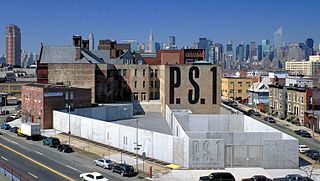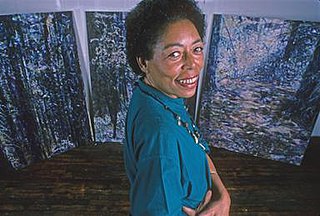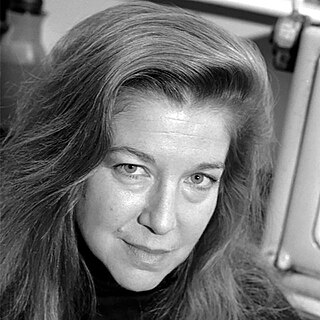
The Museum of Modern Art (MoMA) is an art museum located in Midtown Manhattan, New York City, on 53rd Street between Fifth and Sixth Avenues. The institution was conceived in 1929 by Abby Aldrich Rockefeller, Lillie P. Bliss, and Mary Quinn Sullivan. Initially located in the Heckscher Building on Fifth Avenue, it opened just days after the Wall Street Crash. The museum, America's first devoted exclusively to modern art, was led by A. Conger Goodyear as president and Abby Rockefeller as treasurer, with Alfred H. Barr Jr. as its first director. Under Barr's leadership, the museum's collection rapidly expanded, beginning with an inaugural exhibition of works by European modernists. Despite financial challenges, including opposition from John D. Rockefeller Jr., the museum moved to several temporary locations in its early years, and John D. Rockefeller Jr. eventually donated the land for its permanent site.

Guerrilla Girls is an anonymous group of feminist, female artists devoted to fighting sexism and racism within the art world. The group formed in New York City in 1985, born out of a picket against the Museum of Modern Art the previous year. The core of the group's work is bringing gender and racial inequality into focus within the greater arts community and society at large. The Guerrilla Girls employ culture jamming in the form of posters, books, billboards, lectures, interviews, public appearances and internet interventions to expose disparities, discrimination, and corruption. They also often use humor in their work to make their serious messages engaging. The Guerrilla Girls are known for their "guerrilla" tactics, hence their name, such as hanging up posters or staging surprise exhibitions. To remain anonymous, members don gorilla masks. To permit individual identities in interviews, they use pseudonyms that refer to deceased female artists such as Frida Kahlo, Käthe Kollwitz, and Alice Neel, as well as writers and activists, such as Gertrude Stein and Harriet Tubman. According to GG1, identities are concealed because issues matter more than individual identities, "Mainly, we wanted the focus to be on the issues, not on our personalities or our own work."

MoMA PS1 is a contemporary art institution located in Court Square in the Long Island City neighborhood in the borough of Queens, New York City, United States. In addition to its exhibitions, the institution organizes the Sunday Sessions performance series, the Warm Up summer music series, and the Young Architects Program with the Museum of Modern Art. MoMA PS1 has been affiliated with the Museum of Modern Art since January 2000 and, as of 2013, attracts about 200,000 visitors a year.
Tadanori Yokoo is a Japanese graphic designer, illustrator, printmaker and painter. Yokoo’s signature style of psychedelia and pastiche engages a wide span of modern visual and cultural phenomena from Japan and around the world.

The feminist art movement in the United States began in the early 1970s and sought to promote the study, creation, understanding and promotion of women's art. First-generation feminist artists include Judy Chicago, Miriam Schapiro, Suzanne Lacy, Judith Bernstein, Sheila de Bretteville, Mary Beth Edelson, Carolee Schneeman, Rachel Rosenthal, and many other women. They were part of the Feminist art movement in the United States in the early 1970s to develop feminist writing and art. The movement spread quickly through museum protests in both New York and Los Angeles, via an early network called W.E.B. that disseminated news of feminist art activities from 1971 to 1973 in a nationally circulated newsletter, and at conferences such as the West Coast Women's Artists Conference held at California Institute of the Arts and the Conference of Women in the Visual Arts, at the Corcoran School of Art in Washington, D.C..
The Art Workers' Coalition (AWC) was an open coalition of artists, filmmakers, writers, critics, and museum staff that formed in New York City in January 1969. Its principal aim was to pressure the city's museums – notably the Museum of Modern Art – into implementing economic and political reforms. These included a more open and less exclusive exhibition policy concerning the artists they exhibited and promoted: the absence of women artists and artists of color was a principal issue of contention, which led to the formation of Women Artists in Revolution (WAR) in 1969. The coalition successfully pressured the MoMA and other museums into implementing a free admission day that still exists in certain museums to this day. It also pressured and picketed museums into taking a moral stance on the Vietnam War which resulted in its famous My Lai poster And babies, one of the most important works of political art of the early 1970s. The poster was displayed during demonstrations in front of Pablo Picasso′s Guernica at the MoMA in 1970.
Cornelia H. "Connie" Butler is an American museum curator, author, and art historian. Since 2023, Butler is the Director of MoMA PS1. From 2013 to 2023, she was the Chief Curator at the Hammer Museum in Los Angeles.
The Women's Caucus for Art (WCA), founded in 1972, is a non-profit organization based in New York City, which supports women artists, art historians, students, educators, and museum professionals. The WCA holds exhibitions and conferences to promote women artists and their works and recognizes the talents of artists through their annual Lifetime Achievement Award. Since 1975 it has been a United Nations-affiliated non-governmental organization (NGO), which has broadened its influence beyond the United States. Within the WCA are several special interest causes including the Women of Color caucus, Eco-Art Caucus, Jewish Women Artist Network, International Caucus and the Young Women's Caucus. The founding of the WCA is seen as a "great stride" in the feminist art movement.
Nina Kuo is a Chinese American painter, photographer, sculptor, author, video artist and activist who lives and works in New York City. Her work examines the role of women, feminism and identity in Asian-American art. Kuo has worked in partnership with the artist Lorin Roser.
Mary Beth Edelson was an American artist and pioneer of the feminist art movement, deemed one of the notable "first-generation feminist artists". Edelson was a printmaker, book artist, collage artist, painter, photographer, performance artist, and author. Her works have been shown at the Museum of Modern Art, the Smithsonian American Art Museum, and the Museum of Contemporary Art in Chicago.
New York Feminist Art Institute (NYFAI) was founded in 1979 by women artists, educators and professionals. NYFAI offered workshops and classes, held performances and exhibitions and special events that contributed to the political and cultural import of the women's movement at the time. The women's art school focused on self-development and discovery as well as art. Nancy Azara introduced "visual diaries" to artists to draw and paint images that arose from consciousness-raising classes and their personal lives. In the first half of the 1980s the school was named the Women's Center for Learning and it expanded its artistic and academic programs. Ceres Gallery was opened in 1985 after the school moved to TriBeCa and, like the school, it catered to women artists. NYFAI participated in protests to increase women's art shown at the Museum of Modern Art, The Whitney Museum of American Art and other museums. It held exhibitions and workshops and provided rental and studio space for women artists. Unable to secure sufficient funding to continue its operations, NYFAI closed in 1990. Ceres Gallery moved to SoHo and then to Chelsea and remained a gallery for women's art. However, a group continues to meet called (RE)PRESENT, a series of intergenerational dialogues at a NYC gallery to encourage discussion across generations about contemporary issues for women in the arts. It is open to all.

Xaviera Simmons is an American contemporary artist. She works in photography, performance, painting, video, sound art, sculpture, and installation. Between 2019 and 2020, Simmons was a visiting professor and lecturer at Harvard University. Simmons was a Harvard University Solomon Fellow from 2019-2020. Simmons has stated in her lectures and writings that she is a descendant of Black American enslaved persons, European colonizers and Indigenous persons through the institution of chattel slavery on both sides of her family's lineage.
Clarissa T. Sligh is an African-American book artist and photographer based in Asheville, North Carolina. At age 15, she was the lead plaintiff in a school desegregation case in Virginia. In 1988, she became a co-founder of Coast-to-Coast: A Women of Color National Artists' Project, which focused on promoting works completed by women of color.
The Heresies Collective was founded in 1976 in New York City, by a group of feminist political artists. The group sought to, among other goals, examine art from a feminist and political perspective. In addition to a variety of actions and cultural output, the collective was responsible for the overseeing the publication of the journal Heresies: A feminist publication on art and politics, which was published from 1977 until 1993.

Vivian E. Browne was an American artist. Born in Laurel, Florida, Browne was mostly known for her painting series called Little Men and her Africa series. She is also known for linking abstraction to nature in her tree paintings and in a series of abstract works made with layers of silk that were influenced by her travels to China. She was an activist, professor, and has received multiple awards for her work. According to her mother, Browne died at age 64 from bladder cancer.

Joan Braderman is an American video artist, director, performer, and writer. Braderman's video works are considered to have created her signature style known as "stand up theory." Via this "performative embodiment," she deconstructs and analyzes popular media by inserting chroma-keyed cut-outs of her own body into appropriated mass media images, where she interrogates the representation of ideology and the transparency of photographic space in U.S. popular culture.

Sabra Moore is an American artist, writer, and activist. Her artwork is based on re-interpreting family, social, and natural history through the form of artist's books, sewn and constructed sculptures and paintings, and installations.
Sue Williams is an American artist born in 1954. She came to prominence in the early 1980s, with works that echoed and argued with the dominant postmodern feminist aesthetic of the time. In the years since, her focus has never waned yet her aesthetic interests have moved toward abstraction along with her subject matter and memories. She lives and works in New York.
Lynn Zelevansky is an American art historian and curator. Formerly Henry Heinz II Director of the Carnegie Museum of Art, she is currently based in New York City. Zelevansky curated "Love Forever: Yayoi Kusama" (1998) and "Beyond Geometry: Experiments in Form" (2004) for Los Angeles County Museum of Art from 1995 to 2009. While working at MoMA (1987–1995), she curated “Sense and Sensibility: Women Artists and Minimalism in the Nineties” (1994), that institution's first all-female exhibition. AICA awarded it "Best Emerging Art Exhibition New York."
Margaret Scolari Barr (1901–1987) was an art historian, art critic, educator, translator, and curator.








